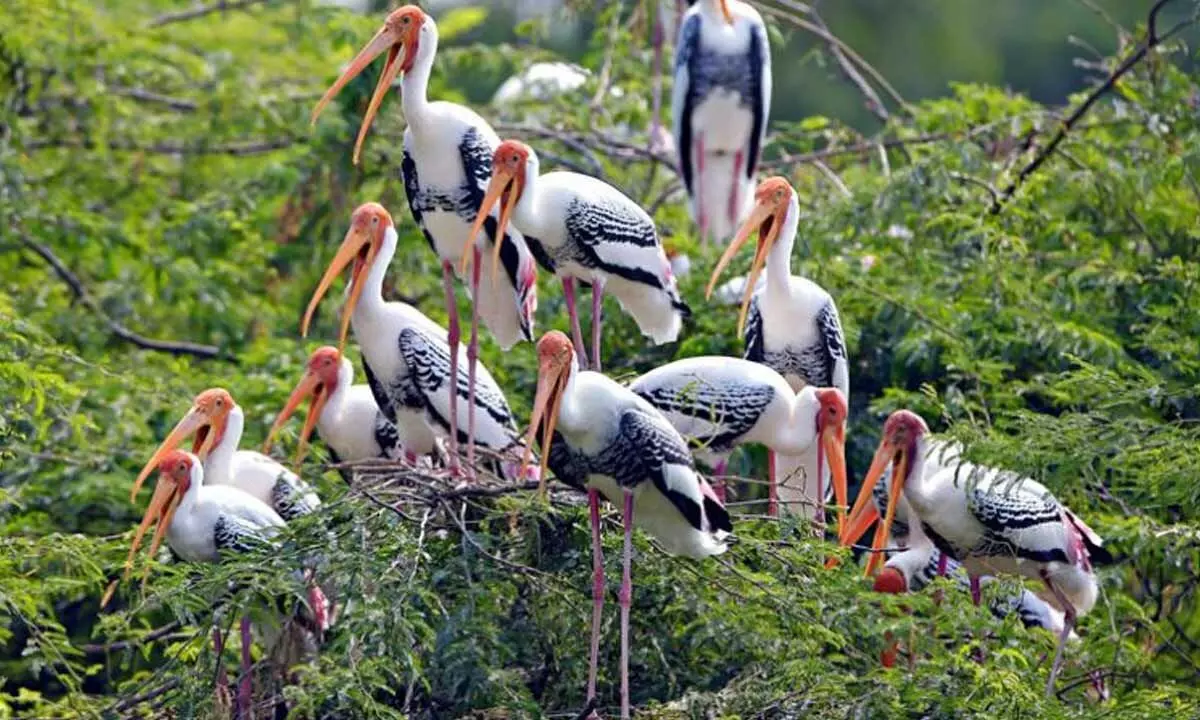Live
- BRS rallies support for Lagacharla ‘victims’
- COP29: Scientists, artists, faith leaders call for greater commitment to delivery of climate finance
- Woman donates liver to husband, saves life
- Mechanic Rocky Review: Thrilling Action Film with Twists and Great Performances
- Ponguleti Sudhakar Reddy rubbishes Rahul Gandhi's claims on Modi and Adani
- ‘We can’t take things for granted’: Jayasuriya on balancing formats and Sri Lanka’s path to WTC final
- Prakash Ambedkar ready to 'power' the winner in Maha polls - Mahayuti or MVA
- BJP plans campaign against Cong govt
- Be lifelines to public & render best, cops told
- Siri 2.0: Apple's Advanced AI Assistant to Be Released in 2026
Just In
UN initiative to protect migratory species


The destruction, degradation and fragmentation of natural habitat is one of the two greatest threats to migratory species of wild animals
The destruction, degradation and fragmentation of natural habitat is one of the two greatest threats to migratory species of wild animals. A major new initiative was launched on Wednesday at the UN wildlife meeting taking place in Samarkand, Uzbekistan, to ensure that areas of importance to migratory species are identified, protected and connected.
Known as the Global Partnership on Ecological Connectivity (GPEC), the announcement took place on the margins of the 14th Meeting of the Conference of the Parties (COP14) to the Convention on the Conservation of Migratory Species of Wild Animals (CMS).
Initiated by CMS, the partnership is joined by several organisations, including Center for Large Landscape Conservation (CLLC), Climate Chance, the Convention on Biological Diversity (CBD), the Convention on Wetlands (Ramsar), the International Union for Conservation of Nature (IUCN), the International Council for Local Environmental Initiatives (ICLEI), UN Convention on Combating Desertification (UNCCD), the UN Environment Programme World Conservation Monitoring Centre (UNEP-WCMC), and the World Wide Fund for Nature (WWF).
Belgium, France, Monaco, and Uzbekistan are among the CMS Parties participating in this new initiative. “The launch of this new global partnership is a direct and immediate response to some of the key recommendations of the flagship CMS report, the State of the World’s Migratory Species, released just two days ago at the opening of COP14. The report calls for increased actions to identify, protect, connect and effectively manage important sites for migratory species. This is exactly what this alliance is about, as it will ensure that actions to address ecological connectivity are mobilized around the world,” said Amy Fraenkel, CMS Executive Secretary.
The GPEC’s overarching objective is to ensure that ecological connectivity is maintained, enhanced, and restored in places of importance for migratory species of wild animals. Migratory species depend on a network of specific types of sites and habitats during their life cycles and seasonal movements. While many such sites have been identified, not all are under any form of protection or conservation. Moreover, many sites of importance have yet to be identified and mapped. Migratory species must be able to reach these sites, often located across national boundaries and there are many impediments to their migrations, including from linear infrastructure such as roads, rail and fences, as well as from other types of human activities.
But ecological connectivity is not just relevant to migratory species. It also plays a major role in addressing effective biodiversity conservation, land restoration and climate change mitigation and adaptation across terrestrial, freshwater, and marine ecosystems.
Defined under CMS as “the unimpeded movement of species and the flow of natural processes that sustain life on Earth”, ecological connectivity is increasingly recognised as a key global conservation priority. It was at the heart of the UN General Assembly Resolution adopted in 2021, “Nature knows no borders: transboundary cooperation -- a key factor for biodiversity conservation, restoration, and sustainable use”.
Led by countries of Central Asia, where the CMS COP14 is being held, the Resolution urges all UN Member States to enhance international and transboundary cooperation to maintain and enhance ecological connectivity of transboundary habitats, cross-border protected areas, and ecosystems that are either vulnerable or part of the migratory range of specific species.
“Nature does not recognise man-made boundaries. Uzbekistan is acutely aware of this fact, as evidenced by the devastating effects of the Aral Sea’s depletion on humans and wildlife across Central Asia and beyond. By contributing to the CMS Global Ecological Connectivity program, Uzbekistan is participating in a worldwide effort to protect migratory species. This collaboration underscores Uzbekistan’s belief in the power of nature to unite nations, necessitating a collective effort to protect it,” said Aziz Abdukhakimov, Minister of Ecology, Environmental Protection, and Climate Change of Uzbekistan and host of COP14.
The importance of ecological connectivity is a major aspect of the Kunming-Montreal Global Biodiversity Framework (GBF) as well, reflected in Goal A on ecosystems, species and genetic diversity, and Targets II on restoration, II on area-based conservation measures, and 12 on enhancing green spaces and urban planning. This new partnership will contribute directly to the implementation of these and other aspects of the GBF. Signed in 1979, the Convention on the Conservation of Migratory Species of Wild Animals (Bonn Convention; CMS) is an environmental treaty under the aegis of the United Nations Environment Programme.
It provides a global platform for the conservation and sustainable use of migratory animals and their habitats. CMS is the only global and UN-based intergovernmental organisation established exclusively for the conservation and management of terrestrial, aquatic and avian migratory species throughout their range. CMS brings together the governments of the countries through which migratory species pass - the Range States; it lays the legal foundation to conduct conservation measures on a global scale. The legal instruments under CMS may range from legally binding Agreements to less formal Memoranda of Understanding and can be adapted to fit the requirements of each region.

© 2024 Hyderabad Media House Limited/The Hans India. All rights reserved. Powered by hocalwire.com






